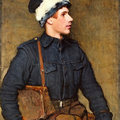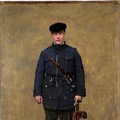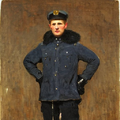Hurmu Constabulary
| Hurmu Constabulary | |
| Abbreviation | HC |
|---|---|
| Formation |
|
| Type | Uniformed Police Force |
| Purpose/focus | Territorial Police |
| Headquarters | Huyenkula |
| Region served | National |
| Official languages | |
| Minister of Policing and Security | Greta Mondosdottra |
| Parent organization | Ministry of Policing and Security |
| Staff |
|
Leadership
| Office | Officeholder | Date Appointed |
|---|---|---|
| Minister of Policing and Security | Greta Mondosdottra | 13.III.1726 AN |
| Former Office Holders | ||
| Minister of Policing and Security | Sigmundr Birgir Tarjeisson | 13.III.1724 AN – 1726 AN |
| Minister of Policing and Security | Ramzan Q̇adar Khan Abakhtari | 8.III.1719 AN – 1720 AN |
| Minister of Policing and Security | Ardashir Bābakān-e Osman | 1690 AN–1708 AN |
| Minister of Policing and Security | Linus Truls Thorgilsson | 1708 AN–1713 AN |
| Minister of Policing and Security | Leila Adalani Djupvik | 11.II.1713 AN–8.III.1719 AN |
| Inspector-General | Ashighemuriin Khadaganasai | 13.VI.1703 AN–12.III.1719 AN |
| Deputy Inspector-General | Gunnar Abdullah Adalani Djupvik | 13.VI.1703 AN–12.III.1719 AN |
| Assistant Inspector-General | Khoga Daidukul | 13.VI.1703 AN–12.III.1719 AN |
| Commissioner for the Constabulary | Walter Nebe | 5.XIII.1704 AN–12.III.1719 AN |
| Commissioner for the Special Auxiliary Constabulary | Emil Six | 5.XIII.1704 AN–12.III.1719 AN |
| Commissioner for Training & Support Services | Otto Jost | 5.XIII.1704 AN–12.III.1719 AN |
| Commissioner for the Liðsskjaldarvaldeð | Einar Almstedt (ESB) | 5.XIII.1704 AN–12.III.1719 AN |
Organisation
Overview
- Hurmu Constabulary
- Command Directorate
- Main Office Command Directorate
- Investigations Directorate
- Main Office Investigations Directorate
- Lake District & Southern District Office
- Apollonian Hurmu Office
- Keltian Hurmu Office
- Territorial Directorate
- Main Office Territorial Directorate
- 1st Division (Lake District)
- 1st Command & Control Regiment
- 1st Circuit Regiment
- 2nd Circuit Regiment
- 3rd Circuit Regiment
- 4th Circuit Regiment
- 5th Circuit Regiment
- 6th Circuit Regiment
- 7th Circuit Regiment
- 8th Circuit Regiment
- Liaison Office, Valvur
- 2nd Division (Svetostrov)
- 2nd Command & Control Regiment
- 9th Circuit Regiment
- 3rd Division (Lontinien)
- 3rd Command & Control Regiment
- 10th Circuit Regiment
- 11th Circuit Regiment
- 12th Circuit Regiment
- 13th Circuit Regiment
- 14th Circuit Regiment
- 15th Circuit Regiment
- 4th Division (Inactive)
- 5th Division (Northern Coria)
- 5th Command & Control Regiment
- 22nd Circuit Regiment
- 23rd Circuit Regiment
- 24th Circuit Regiment
- 25th Circuit Regiment
- 26th Circuit Regiment
- 27th Circuit Regiment
- 6th Division (Transprinitica)
- 6th Command & Control Regiment
- 28th Circuit Regiment
- 29th Circuit Regiment
- 30th Circuit Regiment
- 31st Circuit Regiment
- 7th Division (Keltian Hurmu)
- 4th Command & Control Regiment (Normandie)
- 7th Command & Control Regiment (Ny-Zanzibar)
- 18th Circuit Regiment (Amaland)
- 19th Circuit Regiment (Karnamark)
- 20th Circuit Regiment (Normandie)
- 21st Circuit Regiment (Normandie)
- 32nd Circuit Regiment (Karnamark)
- 33rd Circuit Regiment (Amaland)
- Liaison Office, Samhold Constabulary
- Liaison Office, Phinbellan Federal Police Agency
- Command Directorate
Command Directorate
Responsible for maintaining the discipline, internal standards, and strategic direction of the constabulary.
Investigations Directorate
The Investigations Directorate acquires and develops intelligence, usually of a political or sensitive nature, and conducts investigations to protect the State from perceived threats of subversion and other extremist political activity.
Territorial Directorate
The Territorial Directorate is responsible for policing and security matters across seven territorial divisions corresponding to the states and districts of Hurmu. The majority of resources and manpower are assigned to the territorial divisions which operate circuits within their areas of responsibility.
The Territorial Directorate also maintains liaison offices with local realm law enforcement agencies within their respective division areas.
Duties
The duties of the Hurmu Constabulary, set out in a memorandum issued by the Minister for Policing and Security on 1.X.1690 was:
- Defend the Hanwen u-Brida (Way of Life), by:
- Delivering writs of summons to named individuals, issued by the Senate or by magistrates appointed in their name;
- And by detaining such persons who, having been in receipt of a writ of summons issued by the Senate or by magistrates appointed in their name, has not responded to the summons within the allotted time allowed or at the appropriate place;
- Detaining persons, whose names need not be known at the time of their detention, who, in a violent or riotous manner, distrupt the Brida or else endanger the lives of others or themselves;
- Delivering writs of summons to named individuals, issued by the Senate or by magistrates appointed in their name;
- Enforce Hurmu nationality and residency law;
- Uphold the visa policy of Hurmu;
- Provide support for the Allied Reconstruction Mission in Hurmu;
- Uphold any obligations arising from the Xäiville Convention;
- Provide for the security of:
- Parlerment;
- The Cabinet of the Government of Hurmu;
- The sovereign borders, territorial waters, and air space of Hurmu;
- Ghawlama International Airport;
- Kaupang International Airport;
- Vesüha International Airport;
- Provide for the protection and safety of members of the Order of the Holy Lakes while they are present within the sovereign territory, territorial waters, or air space, of Hurmu.
These duties were reaffirmed in 1724 AN, with the exception of the seventh duty, as this mission had been relinquished to the Hurmu Fyrð following the civil war.
History
On 11.III.1719 the Minister for Policing and Security, Ramzan Q̇adar Khan Abakhtari, declared that the Hurmu Constabulary, as it was then constituted, was an illegal corporate and Humanist militia operating under the guise of a police force. At the minister's direction, the trade union movement, as an emergency measure, received ministerial authorisation to deputise their members as auxiliary constables with orders to peacefully take possession of all buildings, infrastructure, and equipment under the nominal possession of the Hurmu Constabulary and to assume responsibility for the maintenance of civic peace and good order in the districts and states of Hurmu. The minister further directed that members of the Constabulary were to surrender their armaments and warrant badges and withdraw from all involvement in public life, pending interview by appointed investigators for links to extremist groups and corporate militias. Members of the constabulary exonerated from any such associations would subsequently be rehired following a period of retraining in critical legal theory and social awareness. For the duration of the evaluation process, members of the constabulary were to remain at their recorded places of primary residence, during which time they were to be considered suspended from duty and on half pay.
In spite of the best efforts of the deputised trade union volunteers, the period during which the Hurmu Constabulary was stood down was generally considered to be a chaotic one, marred by lawlessness in the peripheral regions and politically motivated factional violence within the cities. The reputation of the new government, and the Minister for Policing and Security accordingly suffered greatly during this time.
By 12.XIII.1719, the Ministry for Policing and Security announced that 22,518 officers had been discharged from the Hurmu Constabulary for collusion with foreign powers, abuses of office, and corrupt associations with corporate bodies. 11,856 officers remained on half-pay pending the completion of critical community relations and legal theory training. 78,214 officers, including former auxiliaries, had been rehired as full time constables.
The organisation of the constabulary was severely disrupted by the 1719–1720 Hurmu civil conflict and thus, whilst the victorious Senatorial faction was obliged to purge the more flagrantly partisan officers, it was felt prudent to leave the system implemented by Ramzan in place.
As of 1724 AN, the active strength of the Hurmu Constabulary had reduced to the point that there was an officer to citizen ratio of 1:464.
With the withdrawal from Eesdeheito in 1743 AN, the 4th Division was stood down and personnel transferred to Hurmudan Keltia.
Uniform
The uniform of an officer in the Hurmu Constabulary initially comprised of a beaver-fur cap, a navy blue waxed-denim single-breasted tunic worn over a white shirt, black woollen trousers, and brown leather riding boots. A black leather shearling lambskin jacket could be worn by officers of the rank of County Inspector 3rd Class, whilst a woollen greatcoat, dyed navy blue, was issued to all ranks to be worn in inclement weather.
By 1714 AN, following the rapid growth of the force over the previous twenty years, a degree of variability had seeped into the once standard uniform. Peaked forage caps had begun to be accepted as head gear, and non-standard tunics and trousers, influenced by regional availability, had begun to appear. And there had been instances where the mandated beaver pelts, used for lining headwear and garments, had been replaced by the fur of sub-boreal foxes.
-
Apprentice Constable, 3rd Demi-Regiment (Southern District)
-
Constable, 4th Division (Eesdeheito)
-
Sergeant, 6th Division (Transprinitica)
-
Parish Constable, 2nd Demi-Regiment (Lake District)
-
County Inspector 1st Class, Air Support (Volunteer) Unit
-
Intelligencer, 1st Demi-Regiment (Lontinien)
The former Constabulary
The Hurmu Constabulary, was established in anticipation of the approval of Parlerment by order of the Minister for Policing and Security on 13.VII.1690, as a police field force consisting of three demi-regiments of mounted-constabulary, six divisions of the Special Auxiliary Constabulary and various other supporting units.
Former structure
- Hurmu Constabulary (Vesüha, Lake District)
- Headquarters Group
- Administrative and Technical Support Unit
- Dogs Unit
- Specialist Fire Arms Section
- Veterinary Unit
- 1st Demi-Regiment (Ghawlama, Lontinien)
- 2nd Demi-Regiment (Kaupang, Lake District)
- 9x Duty Stations (Kaupang)
- County & Parish Patrol Circuits (Lake District)
- 3rd Demi-Regiment (Southern District)
- Air Support (Volunteer) Unit
- Maritime Support Unit
- Training Section
- Special Auxiliary Constabulary
- 1st Division (Lake District)
- 2nd Division (Southern District)
- 3rd Division (Lontinien)
- 4th Division (Eesdeheito)
- 5th Division (Northern Coria)
- 6th Division (Transprinitica)
- Overseas Auxiliary Squadron (Keltian Hurmu)
- Liðsskjaldarvaldeð
- Headquarters Group
Former rank structure
- Inspector-General (OF-8, Lieutenant-General)
- Deputy Inspector General (OF-7, Major-General)
- Assistant Inspector General (OF-6 Brigadier)
- Commissioner (OF-5, Colonel)
- District Inspector (OF-4, Lieutenant-Colonel)
- Adjutant (OF-3, Major)
- Quartermaster (OF-3, Major)
- Intelligencer (OF-3, Major)
- County Inspector 1st Class (OF-3, Major)
- County Inspector 2nd Class (OF-2, Captain)
- County Inspector 3rd Class (OF-1, Lieutenant)
- Probationary Inspector (OF-D, Officer Cadet)
- Parish Constable Major (OR-9, Warrant Officer 1st-class)
- Parish Constable (OR-8, Warrant Officer 2nd-class)
- Sergeant (OR-7, Staff Sergeant)
- Vice-Sergeant (OR-5, Sergeant)
- Constable (OR-4, Corporal)
- Apprentice Constable (OR-3, Lance Corporal)
- Beadle (OR-2, Private 1st-class)
- Chosen Man (OR-1, Private 2nd-class)
Former manpower establishment
| Rank | № |
|---|---|
| Inspector-General | 1 |
| Deputy Inspector-General | 1 |
| Assistant Inspector-General | 1 |
| Commissioners | 4 |
| District Inspectors | 7 |
| Adjutants | 270 |
| Quartermasters | 270 |
| Intelligencers | 270 |
| County Inspector 1st Class | 123 |
| County Inspector 2nd Class | 477 |
| County Inspector 3rd Class | 3,015 |
| Probationary Inspector | 444 |
| Parish Constable Majors | 411 |
| Parish Constables | 2,517 |
| Sergeants | 753 |
| Vice-Sergeants | 13,568 |
| Constables & Apprentice Constables | 4,056 |
| Auxiliaries (Beadles & Chosen Men) | 86,400 |
| Total | 112,588 |
Former equipment and materiel
- Requisition from the Minister for Police and Security, submitted to the Senate on 20.VIII.1690 AN and approved on 01.I.1691 AN.
- Quantity 1,200 beaver-fur caps;
- Quantity 1,200 waxed-denim single-breasted tunics (navy blue);
- Quantity 2,400 leather riding boots (brown);
- Quantity 2,400 woollen trousers (black);
- Quantity 4,800 shirts (white);
- Quantity 4,800 pairs of socks (black);
- The services of ten tailors and their seamstress assistants for a period of two Norton years (renewable);
- The services of one inspector of horses, one chief veterinarian, and twenty stable-hands for a period of two Norton years (renewable);
- One sea-worthy trading barque and crew under a reliable captain;
- Quantity 4,800 Amokolian horses;
- Quantity 1,200 truncheons of the Elw type;
- Quantity 1,200 police pattern cutlasses;
- Quantity 1,200 M1689 service pistol (9×19mm);
- Quantity 1,050 M1686 police rifle (7.62×67mmB);
- Quantity 150 M1591(R) marksman rifle (7.62×67mmB);
- A drawable line of credit for 74,520,000 Craitish Cräite to cover wages and expenses for one Norton year (renewable).
- Received as a donation from the Democratic Republic of Sanama (22.VIII.1692 AN)
- Quantity 10,000 M1581 machine carbine (7.62×39mm);
- Quantity 20,000 M1610 semi-automatic rifle (7.9x57 mm).
- Procured by the the Minister for Police and Security from Sanama Arms Industries:
- Quantity 2,000 SAI SG470 Shotgun.
Former training
Initial training for the volunteers inducted into the Constabulary was undertaken by officers seconded from the the 12th and 22nd Kalisa Rrumëli Field Battalions at Vesüha during the initial formation period (1690 AN – 1691 AN) with a training section established to assume responsibility for the basic training of recruits thereafter.
In-house training was supplemented after 1700 AN by dispatching cadets selected from the children of the Southern District to Tiegang so as to study at the School of the High Inquisitor of Tiegang. Cadets were selected at the age of seven by officers of the Southern District Assistance Board from amongst the orphans being dispatched from the Southern District to serve as apprentices to the Eastern Ulus of the Silver Yak Horde in Lontinien. Of the twelve boys sent in 1700 AN only two, by dint of having falsified papers giving their age as being nine years old, were accepted by the School with the remaining ten being obliged to serve as pot boys in the Blackfriars' Redux and receive a measure of schooling from the staff Saint Richard's Asylum.
Recruits for the Special Auxiliary Constabulary were obliged to furnish their own mounts and riding gear, with remounts and repairs to equipment being a claimable expense.





